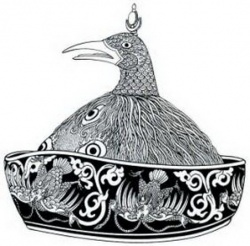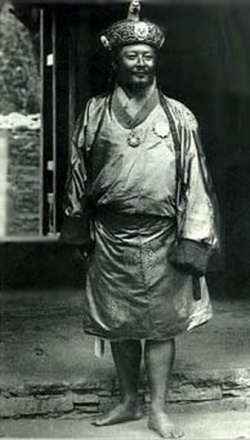Difference between revisions of "The Raven Crown – origin and symbolism"
| Line 2: | Line 2: | ||
[[File:11age047.jpg|thumb|250px|]] [[File:51jj00 .jpg|thumb|250px|]] | [[File:11age047.jpg|thumb|250px|]] [[File:51jj00 .jpg|thumb|250px|]] | ||
<poem> | <poem> | ||
| − | The {{Wiki|Raven}} {{Wiki|Crown}} or Uzha Jarog Dongchen is highly [[symbolic]] of the {{Wiki|Bhutanese}} {{Wiki|monarchy}}. It is the {{Wiki|sceptre}} of the [[King]] of [[Bhutan]]. It is the {{Wiki|personification}} of the [[protector]] [[deity]] of [[Bhutan]], [[Legoen Jarog Dongchen]] (the raven-faced [[protector]] [[deity]]). [[Legoen Jarog Dongchen]] is one of the three [[protector]] [[deities]] of [[Bhutan]], the other two being [[Yeshey Goenpo]] ([[Mahakala]]) and [[Pelden Lhamo]] ([[Mahakali]]). [[Uzha Jarog Dongchen]] establishes the stature of the [[kings]] of [[Bhutan]] as the supreme [[protector]] of the [[people]] and the country just as the [[deity]] the {{Wiki|crown}} represents. The {{Wiki|Raven}} {{Wiki|Crown}} is more than regal {{Wiki|crown}} or a [[symbol]] of kingly authority. Its [[symbolism]] transcends the ordinary and the temporal. | + | The {{Wiki|Raven}} {{Wiki|Crown}} or [[Uzha Jarog Dongchen]] is highly [[symbolic]] of the {{Wiki|Bhutanese}} {{Wiki|monarchy}}. It is the {{Wiki|sceptre}} of the [[King]] of [[Bhutan]]. It is the {{Wiki|personification}} of the [[protector]] [[deity]] of [[Bhutan]], [[Legoen Jarog Dongchen]] (the raven-faced [[protector]] [[deity]]). [[Legoen Jarog Dongchen]] is one of the three [[protector]] [[deities]] of [[Bhutan]], the other two being [[Yeshey Goenpo]] ([[Mahakala]]) and [[Pelden Lhamo]] ([[Mahakali]]). [[Uzha Jarog Dongchen]] establishes the stature of the [[kings]] of [[Bhutan]] as the supreme [[protector]] of the [[people]] and the country just as the [[deity]] the {{Wiki|crown}} represents. The {{Wiki|Raven}} {{Wiki|Crown}} is more than regal {{Wiki|crown}} or a [[symbol]] of kingly authority. Its [[symbolism]] transcends the ordinary and the temporal. |
The {{Wiki|Raven}} {{Wiki|Crown}} is the face of [[Lagen Jarog Dongchen]], which belongs to the powerful [[trio]] of [[protector]] [[deities]] of [[Bhutan]] called [[Goenpo Chamdrel Sum]]. Long before the country assumed the [[name]] of Drukyul, there were many stories of [[Legoen Jarog Dongchen]] playing a highly [[protective]] role in the [[form]] of a {{Wiki|raven}}. | The {{Wiki|Raven}} {{Wiki|Crown}} is the face of [[Lagen Jarog Dongchen]], which belongs to the powerful [[trio]] of [[protector]] [[deities]] of [[Bhutan]] called [[Goenpo Chamdrel Sum]]. Long before the country assumed the [[name]] of Drukyul, there were many stories of [[Legoen Jarog Dongchen]] playing a highly [[protective]] role in the [[form]] of a {{Wiki|raven}}. | ||
Revision as of 12:14, 21 November 2013
The Raven Crown or Uzha Jarog Dongchen is highly symbolic of the Bhutanese monarchy. It is the sceptre of the King of Bhutan. It is the personification of the protector deity of Bhutan, Legoen Jarog Dongchen (the raven-faced protector deity). Legoen Jarog Dongchen is one of the three protector deities of Bhutan, the other two being Yeshey Goenpo (Mahakala) and Pelden Lhamo (Mahakali). Uzha Jarog Dongchen establishes the stature of the kings of Bhutan as the supreme protector of the people and the country just as the deity the crown represents. The Raven Crown is more than regal crown or a symbol of kingly authority. Its symbolism transcends the ordinary and the temporal.
The Raven Crown is the face of Lagen Jarog Dongchen, which belongs to the powerful trio of protector deities of Bhutan called Goenpo Chamdrel Sum. Long before the country assumed the name of Drukyul, there were many stories of Legoen Jarog Dongchen playing a highly protective role in the form of a raven.
One day, Zhabdrung Ngawang Namgyel dreamt of a raven taking flight from his throne while lending him the power to fly with it. The raven led the Zhabdrung to Pangri Zampa, the seat of Lam Ngawang Chogyel, and entrusted him the place for the establishment of a religious centre. Later, when Zhabdrung Ngawang Namgyel fled to Bhutan at the age of 18, Yeshey Goenpo is said to have offered him the country.
Historical sources say that after his arrival in Bhutan, Zhabdrung Ngawang Namgyel was closely attended to by Legoen Jarog Dongchen and helped him achieve success in all his endeavours.
In 1617, when Desi Phuntsho Namgyel of Tsang launched an attack in Paro led by General Laguney, Legoen Jarog Dongchen is believed to have helped the Bhutanese kill the general and defeat the Tibetan forces.
Later, at a religious rite at Pangri Zampa, Legoen Jarog Dongchen is supposed to have brought in a man with him. The deity and the man danced in tune with the long and thunderous clash of the cymbals. At the end of the ritual, Legoen Jarog Dongchen killed the man as a sacrificial object. A few days later, the deity reappeared from Gasa carrying the mutilated limbs of the general of Gelug religious forces. The man the deity had killed at the religious rite in Pangri Zampa had actually been the life-force of the general.
In around 1668, the Tibetans launched a massive assault on Bhutan. Following a bitter flight, a religious rite dedicated to Legoen Jarog Dongchen was performed in Jakar Dzong. As the rite was underway, a match-lock gun was pointed in the direction of Thobgyel Dzong where the Tibetan forces had camped. At the most potent moment of the rite, when the gun was fired, the bullet flied straight to the Tibetan general’s forehead and killed him. This was believed to be the work of Legoen Jarog Dongchen.
Likewise, Legoen Jarog Dongchen is said to have repelled numerous forces from Tibet and Mongolia.
It was in view of the significant roles Legoen Jarog Dongchen played in the shaping of the Bhutanese history that the Raven Crown was adopted as the crown of the leader of Bhutan. Lam Jangchub Tsundru from [[Tsan] Yengoen]] in Tibet who developed a close spiritual relation with Trongsa Penlop Jigme Namgyel (1825 – 1881), conceived, designed, and consecrated the crown.
After adopting the Raven Crown as the symbol of the Bhutanese leader, the protection and security of the country was enhanced manifold. In 1865, the battle with the British India in Dewathang was believed to have been won with the help of Legoen Jarog Dongchen. Moreover, Trongsa Penlop Jigme Namgyel was able to bring the feuding local leaders under his control and consolidate his power principally because of the deity.
There are there versions of the Raven Crown: the crown of the Trongsa Penlop Jigme Namgyel, the crown of the first and the second Druk Gyalpos, and the crown of the third and fourth Druk Gyalpos.
The first and the original version is taller than the latter two. The prominent features in this version are the wing-like side flaps that taper upwards. It has the motif of the sun and the moon in the front and three eyes above it that represent yesheypai chen (the clairvoyant eyes of the extraordinary). Its rim is thinner. On the whole, the crown resembles a religious headgear, ugyen petsho than a crown. It is now preserved at the National Museum of Bhutan in Paro.
The crown worn by the first and the second Druk Gyalpos is modified. It is shorter and flatter, so that the neck of the raven is longer and the head is more prominent. Its rim is much broader with the motif of tantric skull on it. The tantric skulls are rugyen or born decorations mostly associated with wrathful deities. The motif of eyes, however, remains unchanged. The motifs and features, therefore, strongly represent Legoen Jarog Dongchen.
The design of the crown of the third and fourth Druk Gyalpos is almost the same as that of the crown worn by the first two kings. While the breadth of rim remains the same, the motif on it is jachung (Sanskrit: garuda, the king of birds) instead of tantric skulls. That motif of jachung is also relevant to the crown as an enduring symbol of monarchy and majesty of the kings.
While the first version of the Raven Crown bears strong allusions to the protector deity as the supreme agent of national unification and security, latter two, which were modelled on the first prototype, shed some of its immediate symbolism. Fittingly, the crowns modified later, incorporated some motifs that bear secular symbolism and interpretations. The crown worn by the third and fourth Druk Gyalpos represents sceptre, which is secular and immediate, and Legoen Jarog Dongchen, which is religious and transcendental. Above all, it is an enduring symbol of the Bhutanese hereditary monarchy, which is the custodian of national security and well-being. Uzha Jarog Dongchen is the plain representation of the people’s link to the godly and the kingly.

